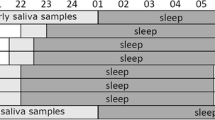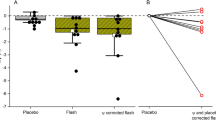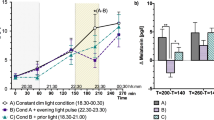Abstract
Appropriately timed exposure to bright light has been shown to phase shift the circadian rhythm and alleviate associated sleeping difficulties. This study evaluated the effectiveness of a newly developed re-timer portable light device for phase delaying the circadian rhythm. Participants included 12 healthy, good sleepers (M = 32.3 years, SD = 12.5, male = 5). A repeated measures counterbalanced design was used to assess circadian phase delay following the use of either the re-timer or no device on two consecutive evenings. Outcome measures included dim light melatonin onset (DLMO), subjective sleepiness, and adverse effects of the re-timer. Analyses revealed a significant phase delay of DLMO following use of the re-timer (M = 46 min, SD = 76 min) on two consecutive evenings when compared to no light control (M = 3 min, SD = 81 min; p = .016). There was a trend for evening subjective sleepiness to decrease after using the re-timer compared to no light control, however this trend was not statistically significant. Adverse effects of the re-timer were headache, eye irritation, and light bothersome to eyes, however these were not severe and treatment was not requested or required. The re-timer device is an effective method of delaying the circadian rhythm in good sleepers.





Similar content being viewed by others
References
Lack LC, Wright HR. Treating chronobiological components of chronic insomnia. Sleep Med. 2007;8(6):637–44.
Czeisler CA, Allan JS, Strogatz SH, Ronda JM, Sanchez R, Rios CD, Freitag WO, Richardson GS, Kronauer RE. Bright light resets the human circadian pacemaker independent of the timing of the sleep wake cycle. Science. 1986;223:667–70.
Lewy AJ, Wehr TA, Goodwin FK, Newsome DA, Markey SP. Light suppresses melatonin secretion in humans. Science. 1980;210:1267–9.
Lewy AJ, Sack RL, Miller LS, Hoban TM. Antidepressant and circadian phase-shifting effects of light. Science. 1987;235:352–4.
Minors SD, Waterhouse JM, Wirz-Justice A. A human phase response curve to light. Neurosci Lett. 1991;133:36–40.
Brainard G, Lewy A, Menaker M, Fredrickson R, Miller L, Weleber R, Cassone V, Hudson D. Effect of light wavelength on the suppression of nocturnal plasma melatonin in normal volunteers. Ann N Y Acad Sci. 1985;453:376–8.
Smith MR, Revell VL, Eastman CI. Phase advancing the human circadian clock with blue-enriched polychromatic light. Sleep Med. 2009;10:287–94.
Wright HR, Lack L. Effect of light wavelength on suppression and phase delay of the melatonin rhythm. Chronobiol Int. 2001;18(5):801–8.
Wright HR, Lack L, Partridge K. Light emitting diodes can be used to phase delay the melatonin rhythm. J Pineal Res. 2001;31(4):350–1.
Wright HR, Lack L, Kennaway DJ. Differential effects of light wavelength in phase advancing the melatonin rhythm. J Pineal Res. 2004;36:140–4.
Dawson D, Campbell SS. Bright light treatment: are we keeping our subjects in the dark? Sleep. 1990;13(3):267–71.
Gaddy JR. Sources of variability in phototherapy. Sleep Res. 1990;19:394.
Voultsios A, Kennaway DJ, Dawson D. Salivary melatonin as a circadian phase marker: validation and comparison to plasma melatonin. J Biol Rhythms. 1997;12(5):457–65.
Horne JA, Ostberg O. A self-assessment questionnaire to determine morningness-eveningness in human circadian rhythms. Int J Chronobiol. 1976;4:97–110.
Nowak R, McMillen IC, Redman J, Short RV. The correlation between serum and salivary melatonin concentrations and urinary 6-hydroxymelatonin sulphate excretion rates: two non-invasive techniques for monitoring human circadian rhythmicity. Clin Endocrinol. 1987;27(4):445–52.
Hoddes E, Zarcone V, Smythe H, Phillips R, Dement W. Quantification of sleepiness: a new approach. Psychophysiology. 1973;10(4):431–6.
Laakso ML, Hatonen T, Stenberg D, Alila A, Smith S. One-hour exposure to moderate illuminance (500 lux) shifts the human melatonin rhythm. J Pineal Res. 1993;15:21–6.
Van Cauter E, Sturis J, Byrne MM, Blackman JD, Leproult R, Ofek G, L’Hermite-Balerlaux M, Refetoff S, Turek FW, Van Reeth O. Demonstration of rapid light-induced advances and delays of the human circadian clock using hormonal phase markers. Am J Physiol. 1994;266(Endocrinol. Metab. 29):E953–63.
Short M, Lack L, Wright H. Does subjective sleepiness predict objective sleep propensity? Sleep. 2010;33(1):123–9.
Lack L, Wright H. The effect of evening bright light in delaying the circadian rhythms and lengthening the sleep of early morning awakening insomniacs. Sleep. 1993;16:423–43.
Lack L, Wright H, Gibbon S, Kemp K. The treatment of early-morning awakening insomnia with two evenings of bright light. Sleep. 2005;28:616–23.
Author information
Authors and Affiliations
Corresponding author
Ethics declarations
Conflict of interest
LL is a stock shareholder in the company RE-Time, PTY. LTD and was involved in the development of the re-timer device. NL has no conflict of interest to disclose. RE-Time, PTY. LTD provided the re-timer devices used in this study.
Rights and permissions
About this article
Cite this article
Lovato, N., Lack, L. Circadian phase delay using the newly developed re-timer portable light device. Sleep Biol. Rhythms 14, 157–164 (2016). https://doi.org/10.1007/s41105-015-0034-6
Received:
Accepted:
Published:
Issue Date:
DOI: https://doi.org/10.1007/s41105-015-0034-6




